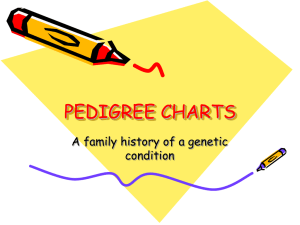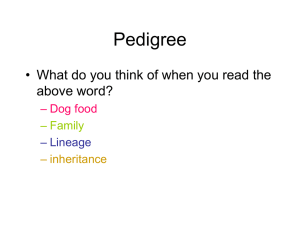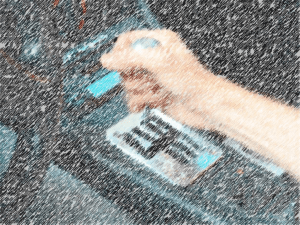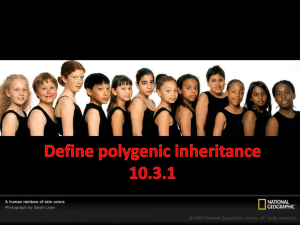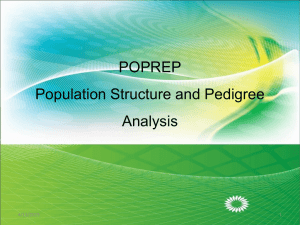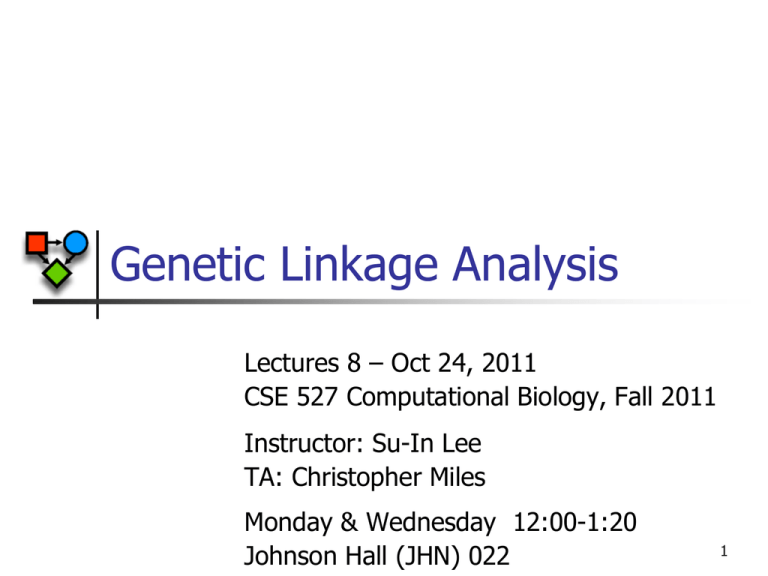
Genetic Linkage Analysis
Lectures 8 – Oct 24, 2011
CSE 527 Computational Biology, Fall 2011
Instructor: Su-In Lee
TA: Christopher Miles
Monday & Wednesday 12:00-1:20
Johnson Hall (JHN) 022
1
Outline
Review: disease association studies
Genetic linkage analysis
Association vs linkage analysis
Pedigree-based gene mapping
Elston-Stewart algorithm
Systems biology basics
Gene regulatory network
2
Genome-Wide Association Studies
Any disadvantages?
Hypothesis-free: we search the entire genome for associations
rather than focusing on small candidate areas.
The need for extremely dense searches.
The massive number of statistical tests performed presents a
potential for false-positive results (multiple hypothesis testing)
genetic markers on 0.1-1M SNPs
Case
G
…ACTCGGTAGGCATAAATTCGGCCCGGTCAGATTCCATACAGTTTGTACCATGG…
A
G
…ACTCGGTGGGCATAAATTCGGCCCGGTCAGATTCCATACAGTTTGTTCCATGG…
A
G
…ACTCGGTAGGCATAAATTCGGCCCGGTCAGATTCCATACAGTTTGTACCATGG…
A
:
:
T
…ACTCGGTGGGCATAAATTCTGCCCGGTCAGATTCCATCCAGTTTGTACCATGG…
C
T
…ACTCGGTGGGCATAAATTCTGCCCGGTCAGATTCCATACAGTTTGTTCCATGG…
A
Control
G
…ACTCGGTGGGCATAAATTCGGCCCGGTCAGATTCCATCCAGTTTGTTCCATGG…
C
G
…ACTCGGTGGGCATAAATTCGGCCCGGTCAGATTCCATCCAGTTTGTACCATGG…
C
G
…ACTCGGTGGGCATAAATTCGGCCCGGTCAGATTCCATCCAGTTTGTACCATGG…
C
:
:
G
…ACTCGGTGGGCATAAATTCGGCCCGGTCAGATTCCATCCAGTTTGTACCATGG…
C
T
…ACTCGGTGGGCATAAATTCTGCCCGGTCAGATTCCATCCAGTTTGTTCCATGG…
C
P-value = 0.2
P-value = 1.0e-7
3
Association vs Linkage Analysis
Any disadvantages?
Hypothesis-free: we search the entire genome for associations
rather than focusing on small candidate areas.
The need for extremely dense searches.
The massive number of statistical tests performed presents a
potential for false-positive results (multiple hypothesis testing)
Alternative strategy – Linkage analysis
It acts as systematic studies of variation, without needing to
genotype at each region.
Focus on a family or families.
4
Basic Ideas
Neighboring genes on the chromosome have a
tendency to stick together when passed on to
offspring.
Therefore, if some disease is often passed to
offspring along with specific marker-genes, we
can conclude that the gene(s) responsible for the
disease are located close on the chromosome to
these markers.
5
Outline
Review: disease association studies
Genetic linkage analysis
Association vs linkage analysis
Pedigree-based gene mapping
Elston-Stewart algorithm
Systems biology basics
Gene expression data
Gene regulatory network
6
Genetic linkage analysis
Data
Pedigree: set of individuals of known relationship
Observed marker genotypes
Phenotype data for individuals
Genetic linkage analysis
Goal – Relate sharing of specific chromosomal regions
to phenotypic similarity
Parametric methods define explicit relationship
between phenotypic and genetic similarity
Non-parametric methods test for increased sharing
among affected individuals
7
Reading a Pedigree
Circles are female, squares are males
Shaded symbols are affected, half-shaded are carriers
Genotypes of certain gene(s) are given for some individuals
What is the probability to observe a pedigree above?
8
Elements of Pedigree Likelihood
Prior probabilities
Transmission probabilities
For founder genotypes
For offspring genotypes, given parents
Penetrances
For individual phenotypes, given genotype
9
Probabilistic model for a pedigree:
(1) Founder (prior) probabilities
Founders are individuals whose parents are not in the
pedigree
They may or may not be typed. Either way, we need to assign
probabilities to their actual or possible genotypes.
This is usually done by assuming Hardy-Weinberg equilibrium
(HWE). If the frequency of D is .01, HW says
1
Dd
P(father Dd) = 2 x .01 x .99
Genotypes of founder couples are (usually) treated as
independent.
Dd
1
2
dd
P(father Dd, mother dd) = (2 x .01 x .99) x (.99)2
10
Probabilistic model for a pedigree:
(2) Transmission probabilities I
According to Mendel’s laws, children get their genes
from their parents’ genes independently:
Dd
1
2
3
Dd
dd
P(children 3 dd | father Dd, mother dd) = ½ x ½
The inheritances are independent for different children.
11
Probabilistic model for a pedigree:
(2) Transmission probabilities II
1
Dd
2
Dd
3
4
5
dd
Dd
DD
P(3 dd, 4 Dd, 5DD | 1 Dd, 2 dd)
= (½ x ½) x (2 x ½ x ½) x (½ x ½)
The factor 2 comes from summing over the two mutually
exclusive and equiprobable ways 4 get a D and a d.
12
Probabilistic model for a pedigree:
(3) Penetrance probabilities I
Independent penetrance model
Pedigree analyses usually suppose that, given the genotype at all
loci, and in some cases age and sex, the chance of having a
particular phenotype depends only on genotype at one locus, and
is independent of all other factors: genotypes at other loci,
environment, genotypes and phenotypes of relative, etc
Complete penetrance
DD
P(affected | DD) = 1
Incomplete penetrance
DD
P(affected | DD) = .8
13
Probabilistic model for a pedigree:
(3) Penetrance probabilities II
Age & sex-dependent penetrance
DD (45)
P(affected | DD, male, 45 y.o.) = .6
14
Probabilistic model for a pedigree:
Putting all together I
1
Dd
Assumptions
2
Dd
3
4
5
dd
Dd
DD
Penetrance probabilities:
P(affected | dd)=0.1, p(affected | Dd)=0.3, P(affected | DD)=0.8
Allele frequency of D is .01
The probability of this pedigree is the product:
(2 x .01 x .99 x .7) x (2 x .01 x .99 x .3) x (½ x ½ x .9)
x (2 x ½ x ½ x .7) x (½ x ½ x .8)
15
Elements of pedigree likelihood
A pedigree
1
g1
2
Bayesian network
representation
g2
x1
4
3
5
x3
For founder genotypes
x4
g5
x5
e.g. P(g1), P(g2)
Transmission probabilities
x2
g3
Prior probabilities
g4
For offspring genotypes, given parents
e.g. P(g4|g1,g2)
Penetrance
For individual phenotypes, given genotype
e.g. P(x1|g1)
Elements of pedigree likelihood
A pedigree
1
g1
2
x1
4
3
Bayesian network
representation
g2
g4
x2
g3
x3
5
x4
g5
x5
Overall pedigree likelihood
L
P(G
f
)
f founders
Probability of founder
genotypes
P(G
o
| Gf , Gm )
{o, f, m}
Probability of offspring
given parents
P(X
i
| Gi )
i individuals
Probability of phenotypes
given genotypes
Probabilistic model for a pedigree:
Putting all together II
To write the likelihood of a pedigree given complete data:
LC
P(G ) P(G | G , G
f
o
f founders
f
m
)
P(X | G )
i
i
i individuals
{o,f, m}
We begin by multiplying founder gene frequencies, followed by
transmission probabilities of non-founders given their parents, next
penetrance probabilities of all the individuals given their genotypes.
What if there are missing or incomplete data?
We must sum over all mutually exclusive possibilities compatible
with the observed data.
L
G1
P(G ) P(G | G , G
f
Gn f founders
All possible genotypes of
individual 1
o
f
m
)
{o,f,m}
If the individual i’s genotype is
known to be gi, then Gi = {gi}
P(X | G )
i
i
i individuals
18
Probabilistic model for a pedigree:
Putting all together II
1
??
g1 {DD , Dd ,dd }
Dd
3
4
5
dd
Dd
DD
P(G
L
2
1
g1 , G2 Dd, G3 dd, G4 Dd, G5 DD)
What if there are missing or incomplete data?
We must sum over all mutually exclusive possibilities compatible
with the observed data.
L
G1
P(G ) P(G | G , G
Gn f founders
f
o
{o,f,m}
f
m
)
P(X | G )
i individuals
i
i
19
Computationally …
To write the likelihood of a pedigree:
L
G1
P(G ) P(G | G , G
f
Gn f founders
o
f
m
{o,f,m}
)
P(X | G )
i
i
i individuals
Computation rises exponentially with # people n.
Computation rises exponentially with # markers
Challenge is summation over all possible genotypes (or
haplotypes) for each individual.
1
??
2
??
3
4
5
??
??
??
20
Computationally …
Two algorithms:
The general strategy of beginning with founders, then
non-founders, and multiplying and summing as
appropriate, has been codified in what is known as the
Elston-Stewart algorithm for calculating probabilities
over pedigrees.
It is one of the two widely used approaches. The other is
termed the Lander-Green algorithm and takes a quite
different approach.
21
Elston and Stewart’s insight…
Focus on “special pedigree” where
Every person is either
Related to someone in the previous generation
Marrying into the pedigree
No consanguineous marriages
Process nuclear families, by fixing the genotype
for one parent
Conditional on parental genotypes, offsprings are
independent
…
Gf
Gm
Go1
Gon
22
Elston and Stewart’s insight…
Conditional on parental genotypes, offsprings are
independent
Thus, avoid nested sums, and produce likelihood whose
cost increases linearly with the number of offspring
L P ( X m | Gm ) P (Gm ) P ( X f | G f ) P (G f ) P ( X o | Go ) P (Go | Gm , G f )
G m G f Go 1
Gon
o1...on
P ( X m | Gm ) P (Gm ) P ( X f | G f )P (G f )
Gm
Gf
Gf
Go1
…
P( X
o
o
| Go ) P(Go | Gm , G f )
Go
Gm
Gon
23
Successive Conditional Probabilities
Starting at the bottom of the pedigree…
Calculate conditional probabilities by fixing genotypes
for one parent
Specifically, calculate Hk (Gk)
Probability of descendants and spouse for person k
Conditional on a particular genotype Gk
Gspouse
Go1
G
G
Gparent =Gk
Gon
G
G
24
Formulae …
So for each parent, calculate
H parent (Gparent )
P( X
spouse
Gspouse
| Gspouse ) P (Gspouse )
P( X
o
Gspouse
Go1
G
G
o
| Go ) P(Go | GparentGspouse )H o (Go )
Go
Gparent
Gon
G
Probability of o’s spouse
and descendants when
it’s genotype is Go
G
By convention, for individuals with no descendants
25
H leaf (Gleaf ) 1
Final likelihood
After processing all nuclear family units
Simple sum gives the overall pedigree likelihood
L
P( X
founder
| Gfounder ) P(Gfounder ) Hfounder (Gfounder )
Gfounder
How?
L
G1
P(G ) P(G | G , G
f
Gn f founders
P(G
founder
Gfounder
o
f
{o,f,m}
) P( X founder | Gfounder )
m
)
P(X | G )
i
i
i individuals
P(G | G , G
Gnonfounder s {o,f,m}
o
f
m
)
P(X | G )
i
i nonfounder s
P(X, given genotypes | Gfounder)=Hfounder (Gfounder)
26
i
What next?
Computation of the pedigree likelihood
For every marker, we want to
Compute the pedigree likelihood for each marker
and choose the marker that is closely linked to the
disease gene.
27
Outline
Review: disease association studies
Genetic linkage analysis
Association vs linkage analysis
Pedigree-based gene mapping
Elston-Stewart algorithm
Systems biology basics
Review: gene regulation
Gene expression data
Gene regulatory network
28
Review: Gene Regulation
a switch! (“transcription factor binding site”)
Gene regulation
DNA
AGATATGTGGATTGTTAGGATTTATGCGCGTCAGTGACTACGCATGTTACGCACCTACGACTAGGTAATGATTGATC
Gene
RNA
Protein
transcription
AUGUGGAUUGUU
MWIV
AUGCGCGUC
AUGCGCGUC
MRV
MRV
AUGUUACGCACCUAC
translation
RNA
degradation
MLRTY
AUGAUUGAU
AUGAUUAU
MID
“Gene Expression”
gene
Genes regulate each others’
expression and activity.
Genetic regulatory network
Gene expression data
Downregulated
Experiments (samples) i
Upregulated
Genes
Induced
Co-expression genes?
⇒ functionally related?
j
Repressed
Eij - RNA level of gene j in experiment i
30
Goal: Inferring regulatory networks
“Expression data”
Experimental
conditions
Q≈2x104
(for human)
Infer the regulatory network that
controls gene expression
Causality relationships among e1-Q
A and B regulate the expression of C
(A and B are regulators of C)
Bayesian networks
e6
e1
…
eQ
B
A
C
31
Clustering expression profiles
Data instances
32
Hierarchical agglomerative
Compute all pairwise distances
u
Merge closest pair
Data instances
33
Clustering expression profiles
Limitations:
Data instances
No explanation on what caused
expression of each gene
(No regulatory mechanism)
Co-regulated genes
cluster together
Infer gene function
34
Goal: Inferring regulatory networks
“Expression data”
Experimental
conditions
Q≈2x104
(for human)
Infer the regulatory network that
controls gene expression
Causality relationships among e1-Q
A and B regulate the expression of C
(A and B are regulators of C)
Bayesian networks
e
e
1
6
…
eQ
B
A
C
35
Regulatory network
Bayesian network representation
Xi: expression level of gene i
Val(Xi): continuous
X1
Interpretation
Conditional independence
Causal relationships
X2
X4
X3
Joint distribution
P(X) =
Conditional probability
distribution (CPD)?
X5
X6
36
Context specificity of gene expression
RNA
level
Context A
Basal expression level
X2
Upstream region
of target gene (X5)
Context B
Activator induces
expression
X1
X4
X3
?
X5
Activator (X3)
X6
activator
binding site
Context C
Activator + repressor
decrease expression
Repressor
(X4)
repressor
binding site
Activator
(X3)
activator
binding site
37
Context specificity of gene expression
X1
RNA
level
Context A
Basal expression level
X2
Context B
Activator induces
expression
X4
X3
Upstream region
of target gene (X5)
?
X5
Activator (X3)
X6
X3
false
activator
binding site
true
X4
Repressor
(X4)
Activator
(X3)
false
P(Level)
P(Level)
P(Level)
Level
0
Context A
repressor
binding site
activator
binding site
true
...
Context C
Activator + repressor
decrease expression
Level
Level
3
-3
38 C
Context B Context
Parameterization
Tree conditional probability distributions (CPDs)
mean (μ) & variance (σ2) of the normal distribution in
each context
X1
Tree CPD
X3
false
(μA,σA)
X2
true
(μB,σB)
false
P(Level)
(μC,σC)
true
P(Level)
...
P(Level)
Level
0
Context A
X4
X3
X4
Level
Level
3
Context B
-3
X5
X6
Context C
39
Reconstructing the network
Training data
Gene expression data
Goal
Learn the structure & tree CPDs parameters
X1
X3
false
X2
true
false
P(Level)
true
P(Level)
P(Level)
Level
(μA,σA) Context A
X4
X3
X4
...
X5
0
Level
Level
3
(μB,σB) Context B
-3
Context C
(μC,σC)
X6
40
Learning
Structure learning
[Koller & Friedman]
Constraint based approaches
Score based approaches
Bayesian model averaging
Given a set of all possible network
structures and the scoring function
that measures how well the model fits the
observed data, we try to select the
highest scoring network structure.
Scoring function
Likelihood score
Bayesian score
X1
X2
X4
X3
X5
X6
41

